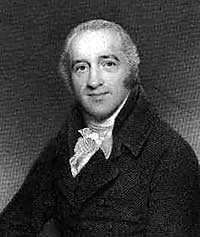Charles Simeon
| Charles Simeon | |
|---|---|
 Portrait of Charles Simeon | |
| Born |
24 September 1759 Reading, Berkshire, England |
| Died | 13 November 1836 (aged 77) |
| Nationality | English |
| Relatives |
Sir John Simeon, 1st Baronet (brother) Sir Richard Simeon, 2nd Baronet (nephew) Sir John Simeon, 3rd Baronet (great-nephew) |
Charles Simeon (24 September 1759 – 13 November 1836), was an English evangelical clergyman.
Biography
He was born at Reading, Berkshire in 1759 and baptised in the parish church on 24 October of that year.[1][2] He was the fourth and youngest son of Richard Simeon (died 1784) and Elizabeth Hutton.[3] His eldest brother, named Richard after their father, died early. His second brother, John, entered the legal profession, became an MP and received a baronetcy. The third brother, Edward Simeon, was a director of the Bank of England.[1]
Simeon was educated at Eton College and King's College, Cambridge.[2] In 1782 he became fellow of King's College, and took orders, receiving the living of Holy Trinity Church, Cambridge, in the following year. He was at first so unpopular that services were frequently interrupted, and he was often insulted in the streets. Having overcome public prejudice, he subsequently gained a remarkable and lasting influence among the undergraduates of the university.
He became a leader among evangelical churchmen, was one of the founders of the Church Missionary Society in 1799, the London Society for Promoting Christianity Amongst the Jews (now known as the Church's Ministry Among Jewish People or CMJ) in 1809, and acted as adviser to the British East India Company in the choice of chaplains for India.
In 1792 he read An Essay on the Composition of a Sermon by the French Reformed minister Jean Claude. Simeon found that their principles were identical and used the essay as the basis for his lectures on sermon composition. Claude’s essay also inspired Simeon to make clear his own theological position, the result being Horae Homileticae, his chief work.
He published hundreds of sermons and outlines of sermons (called "sermon skeletons"), still in print, that to some were an invitation to clerical plagiarism. His chief work is a commentary on the whole Bible, entitled Horae homileticae (London). The Simeon Trust was established by him for the purpose of acquiring church patronage to perpetuate evangelical clergy in Church of England parishes. It continues to operate to this day.
Charles Simeon is often hailed as something of an ancestor of the evangelical movement in the Church of England.[citation needed]
According to the historian Thomas Macaulay, Simeon's "authority and influence… extended from Cambridge to the most remote corners of England, …his real sway in the Church was far greater than that of any primate." [4] He is remembered in the Episcopal Church of the United States with a Lesser Feast and in the Anglican Church of Canada with a Commemoration on 12 November. In the Church of England he is remembered with a Lesser Festival on 13 November. His memorial by the monumental mason Hopper in Holy Trinity Church (Cambridge), was described by architectural critic Nikolaus Pevsner as an "epitaph in Gothic forms."[5]
Notes
- ↑ 1.0 1.1 Simeon 1847, p. 2.
- ↑ 2.0 2.1 "Simeon, Charles (SMN779C)". A Cambridge Alumni Database. University of Cambridge.
- ↑ Simeon 1847, pp. 1–2.
- ↑ The Life and Letters of Lord Macaulay, 1980, p. 50
- ↑ Nikolaus Pevsner. Cambridgeshire. "The Buildings of England." Second Edition (London: Penguin Books, 1970), p.231.
References
- Simeon, Charles (1847). Carus, Rev. William, ed. Memoirs of the Life of the Rev. Charles Simeon. London: Hatchard and Son. Retrieved 31 May 2013.
- http://www.charlessimeon.com
- http://www.simeontrust.org
- http://www.churchsociety.org/churchman/documents/Cman_114_2_Carr.pdf
Bibliography
- Memoirs of Charles Simeon, with a selection from his writings and correspondence, edited by the Rev. W. Carus (3rd ed., 1848).
- W. D. Balda, Spheres of Influence: Simeon's Trust and its implications for evangelical patronage, Cambridge University dissertation (1981).
- Derek Prime, Charles Simeon: An Ordinary Pastor of Extraordinary Influence (Leominster, DayOne, 2011) (History Today).
- Andrew Atherstone, Charles Simeon on “The Excellency of the Liturgy” (Norwich, Hymns Ancient and Modern, 2011) (Alcuin/GROW liturgical study, 72).
 This article incorporates text from a publication now in the public domain: Chisholm, Hugh, ed. (1911). Encyclopædia Britannica (11th ed.). Cambridge University Press
This article incorporates text from a publication now in the public domain: Chisholm, Hugh, ed. (1911). Encyclopædia Britannica (11th ed.). Cambridge University Press
|